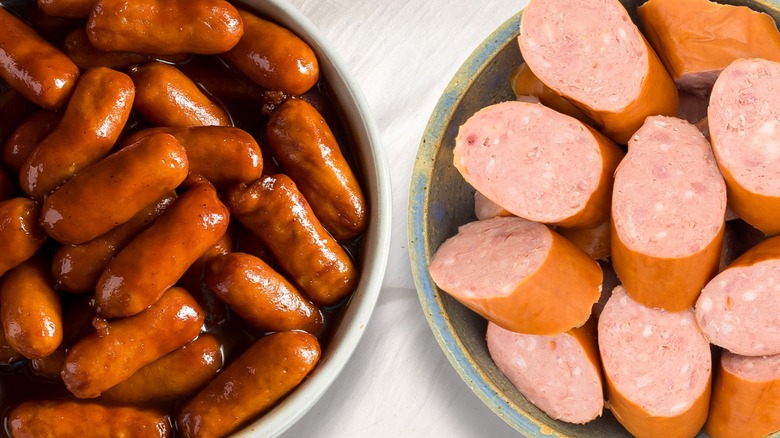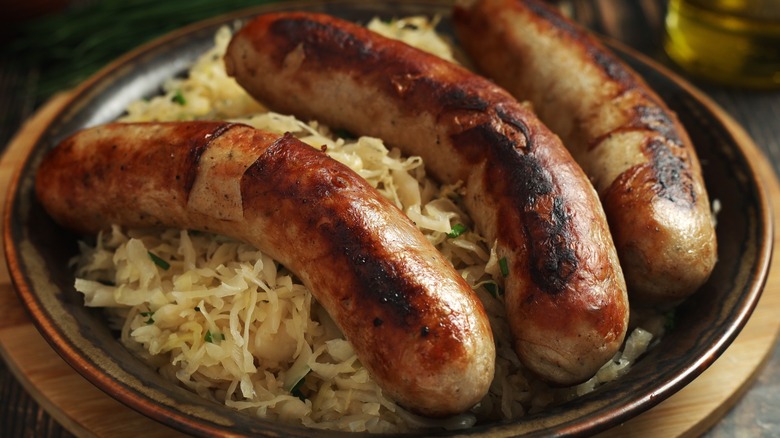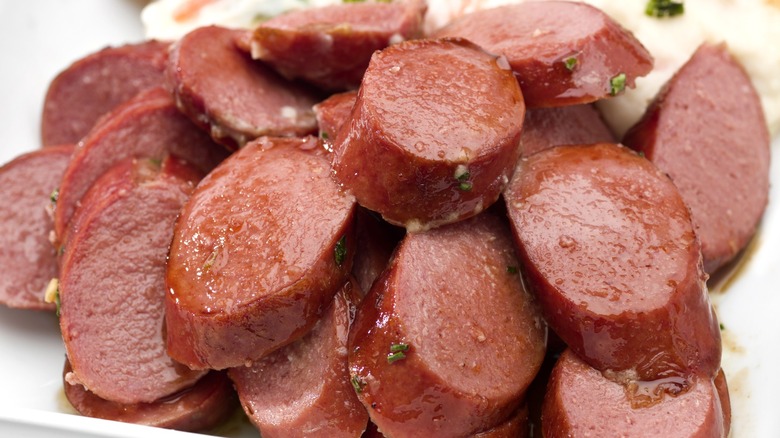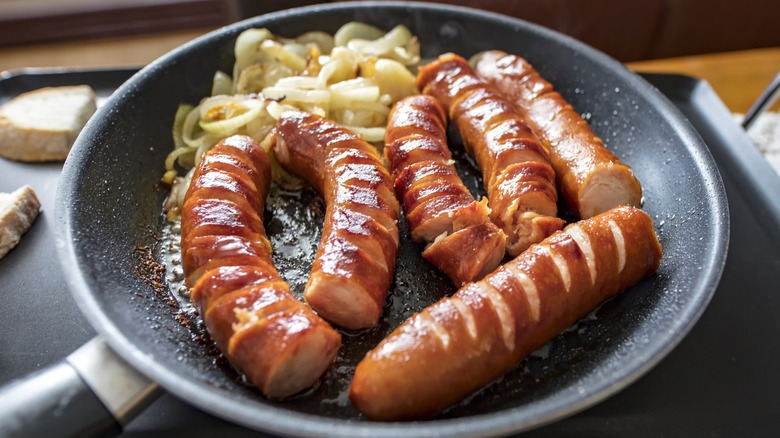What's The Difference Between Bratwurst And Kielbasa?
Ask a meat-lover: All sausages are not created equal. Today, we're deep-diving into two of the most common links, bratwurst and kielbasa. They're both subtler and milder than spicy chorizo or pepperoni. Both are also tightly-packed into casings that provide a satisfying onomatopoeiac "pop" or "snap" when you bite into them. But German bratwurst and Polish kielbasa taste wildly different, and as such, they're better fits for different culinary uses.
Bratwurst is a mildly-spiced German link sausage. Beyond Germany, bratwurst has accrued an enthusiastic international audience. It's common fare in British pubs alongside mashed potatoes and gravy, and is a popular addition to Japanese okonomiyaki savory pancakes. In America, "brats" are served as a hotdog alternative at barbecues and football tailgates, loaded with sautéed onions and green peppers, red pepper flakes, and spicy mustard and paired with coleslaw and potato salad. Specific to the American Midwest, bratwurst are commonly served on Wisconsin's Sheboygan hard rolls, a little-known regional icon.
Polish kielbasa, on the other hand, is something of a culinary chameleon. It's at least as commonly enjoyed sandwich-style as it is as a bold, flavorful sausage ingredient in a myriad of different recipes. Home cooks can use kielbasa in French cassoulet, New Orleans-style red beans and rice, or sweet-spicy Korean-inspired gochujang baked beans, and that's just the beginning of the differences between these two well-known, well-loved European cased meats.
What is bratwurst?
Bratwurst is a fresh (uncooked) link sausage typically made from pork, although veal or beef versions are not uncommon. It's flavored with sweet-spiced seasonings like ginger, nutmeg, coriander, and caraway for a distinctive taste and German culinary profile. Before the advent of refrigeration, the sausage's extended shelf life historically nourished foodies through long, cold Germanic winters.
More specifically, bratwurst is thought to have originated in Nuremberg, Germany, during the medieval era in the 1300s. Other historians debate this origin, instead placing bratwurst's invention even further back with the Celts. Bratwurst's name is inspired by its thrifty way of making use of every part of scrap meat (more on that here). In modern day Thuringia, the annual Thuringian Rostbratwurst Festival is all about celebrating the region's sausage.
German foodies brought bratwurst to the American Midwest when immigration began in the late 1600s, increasing significantly during the 1800s. Perhaps the most well-known variety in North America today is Bavarian bratwurst, which is plump, thick, and meaty with a coarse grain. It's commonly sold in most supermarket refrigerated sausage sections, where it's either long and coiled or pre-cut into shorter hot dog-length segments.
What is kielbasa?
Kielbasa is a Polish sausage — in fact, "kielbasa" is the Polish word for "sausage," and the umbrella-term refers to a fairly wide range of different Polish cased meats. Kielbasa can be made from pork, veal, beef, chicken, or other meats, although pork shoulder and other various pork scraps are most common. It's typically sold as two foot-long, thick, U-shaped sausages weighing between ½ pound and a full pound, or as individual brat-sized links. Some other varieties of kielbasa are shorter and thinner in diameter. It can be dried or smoked, the latter of which accounts for the sausage's signature bright reddish brown hue. The flavor is complex and dimensional, simultaneously rich, smoky, salted, and spiced.
Poland's sausage-making tradition traces back to the 1300s, when kielbasa was commonly made with pork, wild boar, and rabbit. The dried meat boasted a long shelf life to nourish traveling merchants on long journeys, but kielbasa was also enjoyed by nobility and royalty as a delicacy. Its inexpensive assembly facilitated enduring accessibility and popularity, cementing the sausage's place in Polish history and culinary tradition. Fast forward to the late 1800s, and kielbasa arrived in the U.S. with Polish immigrants. Today, kielbasa can be found in specialty Polish grocers, or in most grocery stores in the refrigerated packaged sausage section.
Kielbasa is smoky and spiced, while bratwurst is mild and slightly sweet
Considering that different spices are used to make each sausage variety, it's perhaps no surprise that kielbasa and bratwurst present their own unique flavors. Kielbasa tastes significantly smokier and more garlicky than sweet-savory-mild bratwurst, showcasing a traditional Polish flavor profile of spices. The most readily available version of kielbasa in U.S. supermarkets is kiełbasa zwyczajna, aka "ordinary sausage," which is cured, smoked pork sausage flavored with salt, pepper, marjoram, and garlic. Beyond kiełbasa zwyczajna, other popular varieties of Polish sausage exist under the kielbasa masthead.
Wedding sausage (kiełbasa weselna), for instance, is garlic pork sausage that gets smoked twice, and hunter's kielbasa (myśliwska) is both smoked and dried, and flavored with aromatic juniper berries. There are also different regional varieties of German bratwurst, none of which are as bold or smoky as kielbasa. Thuringian bratwurst is flavored with caraway seeds and garlic, and Franconian bratwurst favors nutmeg. Marjoram is a dominant flavor in bratwurst from Northern Germany, while mace and ginger are more pronounced in the bratwurst of Southern Germany.
Kielbasa is sold pre-cooked and bratwurst is sold raw
It's less common to spy raw fresh kielbasa in North American markets. Outside of Poland, kielbasa is typically smoked, dried, or cured, meaning it's completely cooked and safe to eat straight from the grocery store. Unlike kielbasa, bratwurst is typically sold fresh, aka raw, meaning it must be cooked before it's consumed. Smoked versions can also be found, but are less common. The one exception here is white (aka biala) kielbasa, which is fresh and totally raw, neither cooked nor smoked. It's made from pork with a little beef or veal, and it's a star ingredient in Polish żurek soup, a traditional holiday dish.
Kielbasa is typically grilled, boiled, sautéed, pan-fried, or baked. It can also be incorporated as a rich protein in other recipes like soups, casseroles, or roasted vegetables. You can even hasselback it, which is Ina Garten's preferred method for cooking kielbasa. Kielbasa is a crucial element in Polish kapuśniak cabbage soup, and it's often served plated with sauerkraut and fried onions.
Bratwurst is also frequently pan-fried, boiled, or grilled (tips on that here), but unlike pre-cooked kielbasa, it must reach an internal temperature of 160 degrees Fahrenheit to be safe to eat. Bratwurst are often boiled in beer or smoked to cook. They're commonly served on hard rolls with sauerkraut, as the sour tanginess juxtaposes and brightens the rich sweetness of the sausage. Paired with a lager or ale, bratwurst remains a festive Oktoberfest staple.




